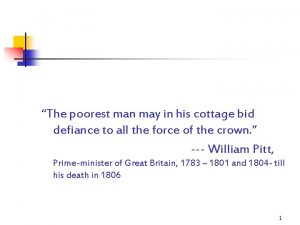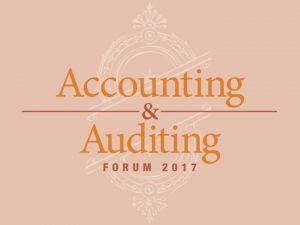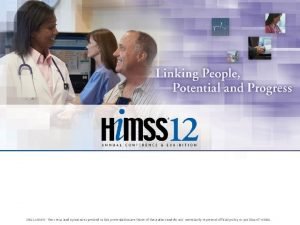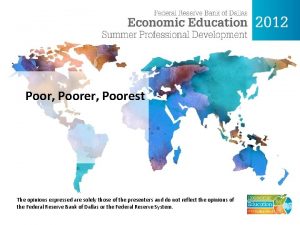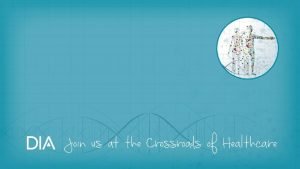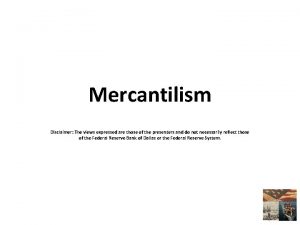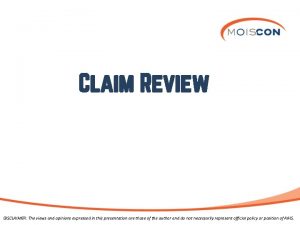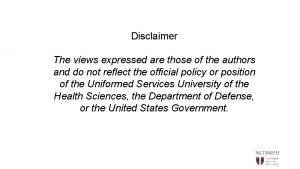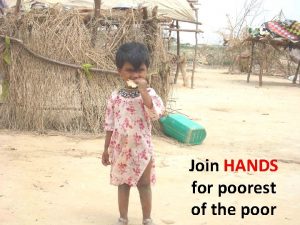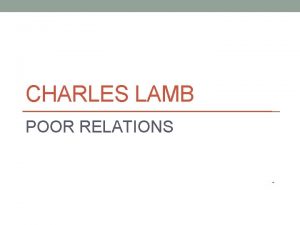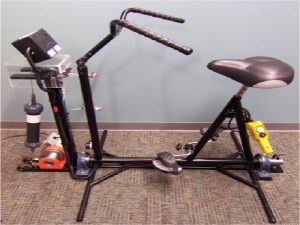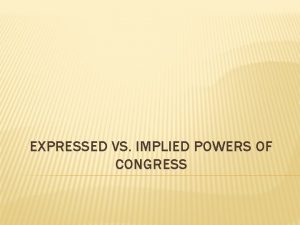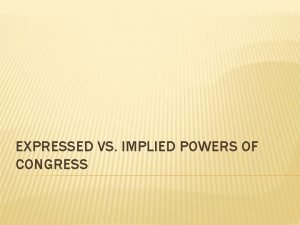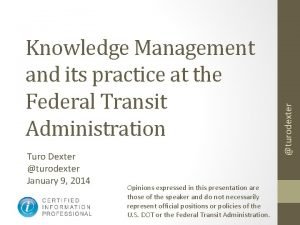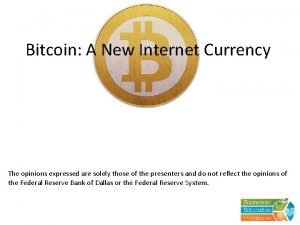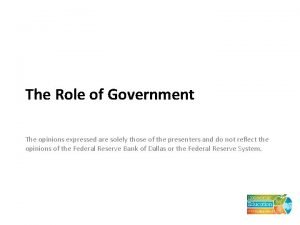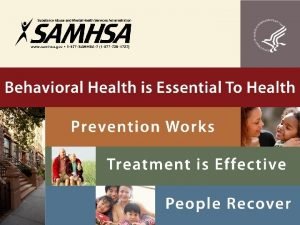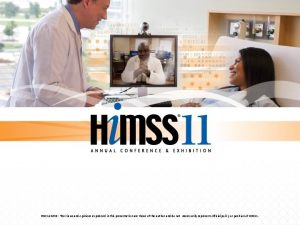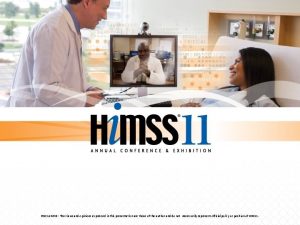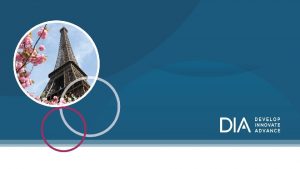Poor Poorest The opinions expressed are solely those








































- Slides: 40

Poor, Poorest The opinions expressed are solely those of the presenters and do not reflect the opinions of the Federal Reserve Bank of Dallas or the Federal Reserve System.

Defining Poverty • Condition of having little or no money, goods or means of support • U. S. poverty threshold $18, 1061 • 2497. 4 hours of work at minimum wage • 312 full-time work days 1. Threshold from the Census Bureau 2011 Poverty Thresholds by Size of Family and Number of Children. Household has 2 adults, one under 18 dependent and a head of household under 65 years of age. http: //www. census. gov/hhes/www/poverty/data/threshld/index. html

Poor: U. S. Poverty Statistics 1 • In 2010 – 46. 2 million people – 15. 1 percent of the population lived in poverty – 16. 4 million are under the age of 18 – 20. 5 million lived at less than half their poverty level. 1. United States. Dept. of Commerce. Income, Poverty, and Health Insurance Coverage in the United States: 2010. Washington: GPO, 2011.



Near Poverty • In 2010, – Over 60 million Americans lived below 1. 25 times their poverty threshold. – Over 75 million lived below 1. 5 times their poverty threshold.

Living in Poverty (U. S. ) • Spring of 2011, – 21. 8 million households, or 69. 2 million adults lived in doubled-up households. • A family of four, living at the 2012 poverty line ($23, 050) qualifies for a maximum home price of $61, 327. • In San Antonio, that will gain you access to 15% of the housing stock.

Poor, but not impoverished • The current poverty thresholds do not adjust for rising levels and standards of living that have occurred since 19651. • Thresholds do not account for variation in cost of living. 1. Short, Kathleen. The Research Supplemental Poverty Measure: 2010. Washington: GPO, 2011.

U. S. Minimum Wage is Not Globally Poor • 5. 15 billion people live on less than $10 per day.

Poorer: Two Dollars a Day • Median poverty line in the developing world. • Adjusted for purchasing power parity. • 2. 6 billion people

What is Purchasing Power Parity? • Is an implicit exchange rate. • How much money is necessary to purchase the same goods and services in different countries. • A person living on “Two dollars a day” in different countries will be able to purchase the same amount of goods and services.

Access to Basic Needs • More than two-thirds of people without clean water live on less than $2 dollars a day. • 2. 4 billion people worldwide do not have access to adequate sanitation.

Living on Two Dollars a Day • What would you eat on two dollars a day in the U. S. ? – Two double cheeseburgers a day (880 calories). – 3. 4 lbs. of rice(5, 598 calories)1 • After food, what would you have left? 1. Based on advertised price at Wal-Mart of $11. 86 for 20 lbs.

A Developing World Problem? • 1. 46 million Americans live on less than two dollars a day. 1 • Even accounting for food assistance programs 795 thousand Americans live on less than two dollars a day 1. Shaefer, H. Luke and Kathryn Edin. Extreme Poverty in the United States, 1996 to 2011, National Poverty Center Policy Brief #28

Geographic Breakdown 1 1. Map created at www. gapminder. com. Circles represent the percent of a country’s population living on less than $2 a day.

Poorest: Less than $1. 25 a day • 1. 29 billion people • Roughly 22 percent of the developing world • Adjusted for purchasing power parity.

Access to Basic Needs • One third of all people who do not have access to clean water live on less than $1. 25 a day.

Geographic Breakdown 1 1. Map created at www. gapminder. com. Circles represent the percent of a country’s population living on less than $2 a day.

Regional Percentages of Extreme Poverty

Progress in Asia • East Asia and the Pacific – 1981 - 77 percent below $1. 25 a day – 2008 – 14 percent below $1. 25 a day • South Asia – 1981 – 61 percent below $1. 25 a day – 2008 – 36 percent below $1. 25 a day

Little Progress in Sub-Saharan Africa • 1981 – 51 percent under $1. 25 per day • 2008 – 47 percent under $1. 25 per day

Should the U. S. Give Aid? • Is it helping? • Is it hurting? • In what form should aid be given?

Some Aid Terminology • Official Development Assistance (ODA): Public Sector Aid • Private Development Assistance: Private Sector Aid • Public-Private Partnerships (PPPs): ODA and Private and Philanthropic Leadership

More Aid Terminology • Unilateral Aid: Given by one country to another. • Multilateral Aid: Aid delivered by an international organization.

Should the U. S. Aid? Yes • Many economists believe there is a framework of aid that may be valuable to the developing world. • They differ on the structure, planners and recipients.

Sachs on Aid: We must do more • The West has committed hundreds of billions of dollars to aid and has not delivered. • This aid is necessary to help the poorest countries even begin the ascent out of poverty. • One such undelivered promise is the Millennium Development Goals.

Sachs on Aid, cont. • Does not believe that corruption and mismanagement is to blame for lingering poverty. • Does admit that corruption and lawlessness will destroy an economy. • Has addressed both top-down and bottom-up approaches, in both cases, believes significant coordination of large scale aid is required.

Easterly on Aid: Fund Individuals • Aid has failed because of corruption and paternalistic delusion. • Top-down goals, like the Millennium Development Goals are doomed. • We should fund non-profits, shift to smaller, incremental projects, and hold the providers responsible.

Easterly on Aid, cont. • Badly governed countries are poor. • Top 15 aid recipients in 2002 all have governments ranked in the bottom quartile. • Aid has tried and failed to change the quality of government. • More aid has tried and failed more.

Common critique of Sachs and Easterly • Both acknowledge the role of well defined and protected private property, but both undersell the impact. • Neither are looking at the incentives of recipient governments or individuals as the driving force behind outcomes.

Support of the Critics • China, the strongest success story in recent history, focused on bolstering entrepreneurship and fostering business investment.

Banerjee and Duflo • Aid should not seek to change the condition of the poor through large scale projects. • Small projects should seek to marginally, but efficiently, improve the lives of the poor. • Small projects should be evaluated quantitatively.

Familiar Methodology, Novel Application • Random Control Trials (RCTs) are familiar to the pharmaceutical industry. • Some people receive the drug, some the placebo, observe outcomes for trends. • This methodology was used to answer small questions about aid projects.

Using the Trials to Direct Action • Based on the results of RCTs, small policy decisions can be made to maximize the impact per dollar spent. • The goal is to allow impartial data, not preconceived notions to dictate action.

An Example of RCTs • If the goal is to increase school attainment we could offer – Extra Teachers – Free Meals – Deworming – Information of Returns

The Results of the RCT • Extra years of schooling per $100 – Extra Teachers 1. 7 years – Free Meals 2. 8 years – Deworming 28. 6 years – Information of Returns 40. 0 years

Critiques of Banerjee and Duflo • Can’t answer big questions. • Only improve life of poor at the margin. • Ethical Concerns?

Should the U. S. Aid? No • George B. N. Ayittey – Africa has the resources to become self-sustaining. – The problem is reliance on Western Aid. – Corruption has squandered, in some cases all of the aid given to African countries

Should the U. S. Aid? No • Countries who have seen significant progress against extreme poverty have not been the large aid recipients. • Free markets and private property protection are the most important aspects of ascent from poverty.

Summary • Many economists believe there is economic value to recipients of aid. • There is substantial disagreement to the type and structure of aid. • There are some who say the condition of certain nations make aid useless. • The most successful stories of poverty reduction are about countries that have focused on entrepreneurship and private property protection.
 Disclaimer
Disclaimer Antigentest åre
Antigentest åre The poorest man may in his cottage
The poorest man may in his cottage Disclaimer the opinions expressed
Disclaimer the opinions expressed Views and opinions disclaimer
Views and opinions disclaimer The views and opinions expressed
The views and opinions expressed Views expressed disclaimer example
Views expressed disclaimer example All opinions expressed disclaimer
All opinions expressed disclaimer The views and opinions expressed disclaimer abs-cbn
The views and opinions expressed disclaimer abs-cbn The views expressed disclaimer
The views expressed disclaimer Sprint backlog belongs solely to the
Sprint backlog belongs solely to the Fecboak
Fecboak Các châu lục và đại dương trên thế giới
Các châu lục và đại dương trên thế giới Thế nào là hệ số cao nhất
Thế nào là hệ số cao nhất Hệ hô hấp
Hệ hô hấp Tư thế ngồi viết
Tư thế ngồi viết đặc điểm cơ thể của người tối cổ
đặc điểm cơ thể của người tối cổ Mật thư anh em như thể tay chân
Mật thư anh em như thể tay chân Bổ thể
Bổ thể Tư thế worm breton
Tư thế worm breton ưu thế lai là gì
ưu thế lai là gì Tư thế ngồi viết
Tư thế ngồi viết Thẻ vin
Thẻ vin Thể thơ truyền thống
Thể thơ truyền thống Cái miệng bé xinh thế chỉ nói điều hay thôi
Cái miệng bé xinh thế chỉ nói điều hay thôi Các châu lục và đại dương trên thế giới
Các châu lục và đại dương trên thế giới Từ ngữ thể hiện lòng nhân hậu
Từ ngữ thể hiện lòng nhân hậu Diễn thế sinh thái là
Diễn thế sinh thái là V. c c
V. c c Làm thế nào để 102-1=99
Làm thế nào để 102-1=99 Chúa yêu trần thế alleluia
Chúa yêu trần thế alleluia Tỉ lệ cơ thể trẻ em
Tỉ lệ cơ thể trẻ em Hổ đẻ mỗi lứa mấy con
Hổ đẻ mỗi lứa mấy con đại từ thay thế
đại từ thay thế Quá trình desamine hóa có thể tạo ra
Quá trình desamine hóa có thể tạo ra Vẽ hình chiếu vuông góc của vật thể sau
Vẽ hình chiếu vuông góc của vật thể sau Công của trọng lực
Công của trọng lực Hình ảnh bộ gõ cơ thể búng tay
Hình ảnh bộ gõ cơ thể búng tay Thế nào là mạng điện lắp đặt kiểu nổi
Thế nào là mạng điện lắp đặt kiểu nổi Dot
Dot Lời thề hippocrates
Lời thề hippocrates


